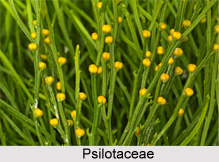 Psilotophyta group of plants lacks roots and leaves. Its structure is similar to the fossil specie Rhynia. Tmesipteris has a complex morphology. Both the species of this group have compound sporangia called synangia. It possesses a stem that displays primitive dichotomous type of branching. In the case of Psilotum the sporangia are three-parted.
However they both have aerial branches that arise from stems embedded in its substrate.
Psilotophyta group of plants lacks roots and leaves. Its structure is similar to the fossil specie Rhynia. Tmesipteris has a complex morphology. Both the species of this group have compound sporangia called synangia. It possesses a stem that displays primitive dichotomous type of branching. In the case of Psilotum the sporangia are three-parted.
However they both have aerial branches that arise from stems embedded in its substrate.
Branching occurs dichotomously and is obvious in the aerial branches of Psilotum. Psilotum lacks true leaves and it possesses leaf-like extensions of the stem called enations. As they lack vasculature they are not considered leaves. The foliar structures of Tmesipteris species are vascularized.
Psilotaceae
This is a family of fern-like plants that consists of Psilotum and Tmesipteris. Psilotum consists of small shrubby plants commonly known as "Whisk ferns". Tmesipteris is an epiphyte. The small outgrowths called enations are not considered true leaves as there is only a vascular bundle
underneath them.
Scientific Classification
Kingdom: Plantae
Division: Pteridophyta
Class: Psilotopsida
Order: Psilotales
Family: Psilotaceae
These plants are the least complex of all terrestrial vascular plants. Both the species grow in tropical and subtropical regions, where they occur on rich soil. Psilotum is also found as a common weed in greenhouses.
Morphology and Life History of Psilotaceae
The psilophyte stem is anchored by a horizontally creeping stem called a rhizome. The enations lie immediately below the synangia which produce the spores. The synangia appear to be the product of three sporangia which became fused and are borne on the tip of a short lateral branch.
When the synangia mature, when they open yellow spores are released. From this gametophyte plants emerge. The gametophytes are very small and measures less than two millimeters long. They are subterranean and saprophytic. The gametophyte reaches sexual maturity, producing both egg and sperm cells. Multiflagellate sperm swims to the egg cells. Here they unite to begin generation of sporophyte.
The mature sporophyte of Psilotum grows upto 30 cm. The stem is green and photosynthetic and it is covered with stomates in order to allow gas exchange. There is a layer that surrounds the vascular tissue called the endodermis. Tmesipteris has broad leaf-like extensions each has a single vascular bundle. These extensions form a flat growth or may be radially arranged.



















